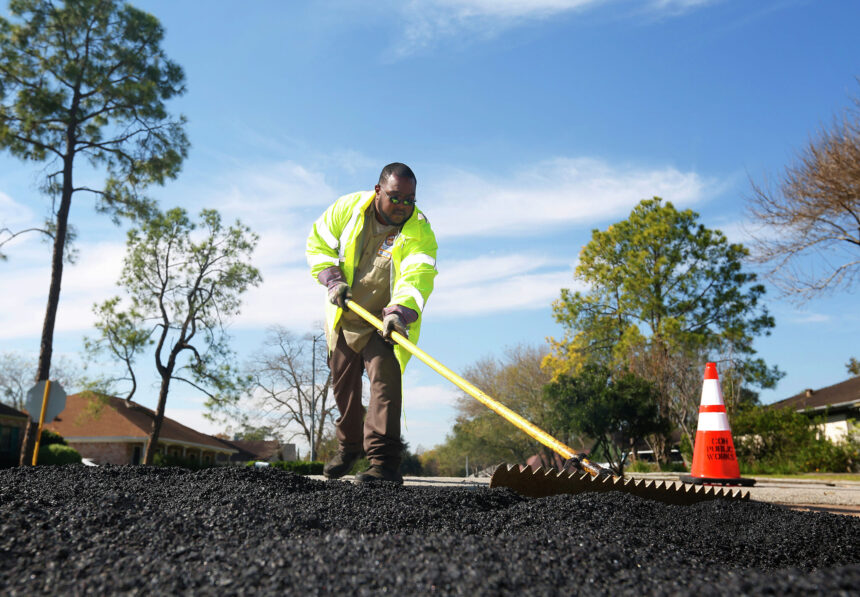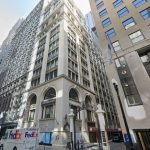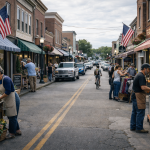Robert Poole uses a rake to smooth and grade hot asphalt as the City of Houston crew he is a part of fills a pothole in Houston.
Houston ChronicleWelcome to Heat Week. From July 1 until July 5, Chron is looking at how heat has defined our lives in Houston and Texas—the good, the bad and the sweaty.
If you’ve ever taken a walk on a hot summer day and happened to pass under the shade of a beautiful, big tree—even if only briefly—then you know the difference that shade can make in dealing with the Houston heat.
But in Houston, shade is scarce. An analysis from the Kinder Institute for Urban Research found that Harris County lost roughly 10 percent of its tree coverage between 2011 and 2021. And that’s not all, thanks to climate change, the earth is getting warmer. Last year, the National Oceanographic and Atmospheric Administration recorded the hottest summer on record (in its 174-year history) at 2.59 degrees Fahrenheit above average. And as we’ve all witnessed, this summer seems to be scorching hot already (with a heaping side of humidity).
Article continues below this ad
As the Texas summer continues to bring more inescapable heat, the urgency of reducing urban heat picks up steam.
But the city of Houston has a plan for that, starting by restoring the natural forests near its waterways. According to the Texas General Land Office’s Resiliency Master Plan, Houston aims to plant 200,000 trees along narrow strips of land adjacent to the bayous as part of the Houston Parks and Recreation Department’s “Riparian Restoration Initiative.” Since YEARTK, the city has planted 35,000.
Riparian zones, or the areas between land and a river, stream or bayou, act as buffers between upland areas and open water. Many of Houston’s riparian forests have been damaged, razed or invaded by non-native species—not just hurting flood mitigation, but also heat reduction efforts.
“In general, those trees are improving heat in Houston, not just by [an individual] standing under a tree,” said Kelli Ondracek, natural resources manager at the parks department. “Trees cool adjacent areas so those trees are providing a cooler Houston.”
Article continues below this ad
Trees help absorb the sun’s rays during the summertime, causing the areas just under the tree to receive just 10 to 30 percent of the sun’s heat. Additionally, more trees help cool the area via the transpiration of water through their leaves, which has a cooling effect, combined with shade, that can lower temperatures by 2 to 9 degrees Fahrenheit, according to a report by Grist.

Map highlights the density of tree-provided shade in the greater Houston area. Some of the worst shade deserts include Alief, downtown Houston, Almeda, Pearland, Deer Park, and Katy.
Source: Tree Equity ScoreThe parks department identified 70 parks and waterways in southeast Houston that require restoration. So far, 26 sites have been completed according to TreePlotter.
But what’s the hold-up in hitting the 200,000 goal? Well, it’s the usual suspects: lack of funding and personnel.
Article continues below this ad
The program’s been years in the works. Its first pilot projects began in 2017 when the department received some funding to restore Milby Park and White Oak Parkway, Ondracek told Chron.
After that, they were able to secure funding from the Texas Environmental Quality Commission and the General Land Office to move into new projects. However, according to the Resiliency Master Plan, the entire initiative has not been fully funded, only certain individual projects. The total cost of the project is estimated at $4 million.
And as the department tackles more projects, there are not enough personnel to go back and maintain the sites. The department must be vigilant the first year after a site is restored, but after a few years, older sites are maintained only once a year. However, as they keep adding sites, keeping an eye on multiple young sites is a difficult task.
“As we add sites on and get closer to 70 sites, we’re still going back to the sites we restored,” Ondracek said. “We’re adding additional [planting] sites every year without really adding additional staff … The biggest challenge is just making sure that all of those sites continue to do well and don’t get overgrown with vines and invasive species.”
Article continues below this ad
Riparian restoration projects plant native trees including River Birch, Pecans, southern Magnolias, American Holly, Sweetgum, American Sycamores, Loblolly Pine, Eastern Cottonwood, Black Cherry, White Oak, Southern Red Oak, and many more. The parks department adds interpretive signage in all its projects to identify and inform residents of native plant species.
The Houston Parks Department recently worked on a rare riparian restoration of Watonga Park, doing a “forested bumper” on both sides of the bayou. Ondracek shared that next year, the department will begin work on Hermann Brown Park to enhance its existing riparian forest.
As they continue to work on more sites, Ondracek believes they will reach the 200,000 tree goal.
Article continues below this ad
“I think that we will at least hit that amount for the project,” Ondracek said.











